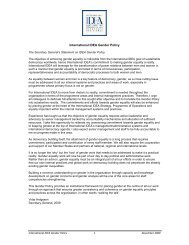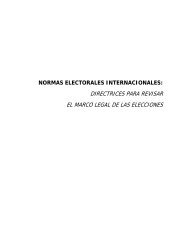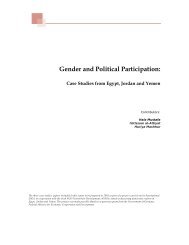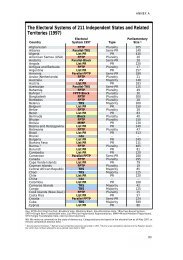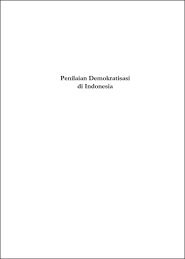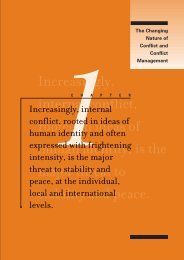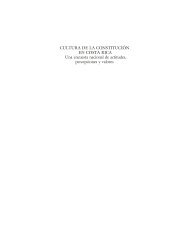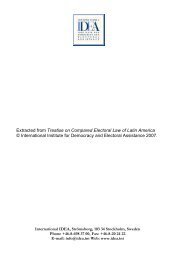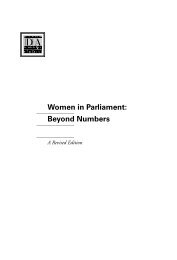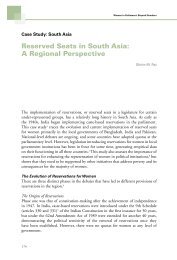The Role of State Constitutions in Protecting ... - International IDEA
The Role of State Constitutions in Protecting ... - International IDEA
The Role of State Constitutions in Protecting ... - International IDEA
You also want an ePaper? Increase the reach of your titles
YUMPU automatically turns print PDFs into web optimized ePapers that Google loves.
<strong>The</strong> 1947 Union Constitution, which was proclaimed <strong>in</strong> September 1947,<br />
provided for a semi-unitary state: M<strong>in</strong>isterial Burma occupied the position <strong>of</strong> a<br />
Mother unit – the Pyi-Ma, <strong>in</strong> Burmese. <strong>The</strong>re were <strong>in</strong> addition, four subord<strong>in</strong>ated<br />
units or states 5 : the Ch<strong>in</strong> Special Division, the Kach<strong>in</strong> <strong>State</strong>, the Shan <strong>State</strong>, and<br />
the Karenni <strong>State</strong>, which had their own executive and legislative bodies, but no<br />
constitution <strong>of</strong> their own. <strong>The</strong>ir power or responsibilities and autonomy were<br />
def<strong>in</strong>ed or provided for <strong>in</strong> sections <strong>of</strong> the Union constitution – which was<br />
practically the constitution <strong>of</strong> the Pyi-Ma (or the Mother state). In effect, the<br />
constituent states <strong>of</strong> the union were subord<strong>in</strong>ates <strong>of</strong> the Mother state (or Burma<br />
Proper) 6 .<br />
Remarkably, although the Union was <strong>in</strong> effect semi-unitary, there was <strong>in</strong>cluded a<br />
constitutional clause that permitted secession 7 . <strong>The</strong> Kach<strong>in</strong> <strong>State</strong> government <strong>in</strong><br />
fact renounced the state <strong>in</strong> the mid-1950s and claim<strong>in</strong>g the right <strong>of</strong> secession<br />
provision became a thorn <strong>in</strong> the side <strong>of</strong> the military. It provided the military<br />
leadership and General Ne W<strong>in</strong> with a cause: a duty to prevent secession and the<br />
break up <strong>of</strong> the Union at all cost.<br />
Although the 1947 Union Constitution was not <strong>in</strong> l<strong>in</strong>e with letter or spirit <strong>of</strong> the<br />
Panglong Accord signed <strong>in</strong> February 1947, it was understood that it could be<br />
amended <strong>in</strong> the future. Thus, <strong>in</strong> the early 1960s, the constituent states led by Sao<br />
Shwe Thaike 8 , <strong>in</strong>itiated a move to amend the 1947 Union constitution, to make<br />
it “genu<strong>in</strong>ely federal”. In response, General Ne W<strong>in</strong> staged a coup, claim<strong>in</strong>g that<br />
the military had to step <strong>in</strong> to foil a secessionist plot, and to “clean up the mess”<br />
made by <strong>in</strong>competent, sp<strong>in</strong>eless, and corrupt politicians.<br />
Under Ne W<strong>in</strong> and successor rul<strong>in</strong>g generals, the mean<strong>in</strong>g <strong>of</strong> federalism has been<br />
grossly distorted. Federalism has been equated with secession and the<br />
fragmentation <strong>of</strong> the country. This is so despite the cont<strong>in</strong>ued celebration <strong>of</strong><br />
February 12th – the day the Panglong Accord was signed – as Union Day, and<br />
despite the rhetoric and slogans about the equality <strong>of</strong> “national races”. It is<br />
remarkable that federalism should be equated with secession when the term<br />
”Union” <strong>in</strong> Burmese (the language <strong>of</strong> the Burman) – Pyidaung-zu – is<br />
unambiguous. “Pyidaung-zu” means the com<strong>in</strong>g together <strong>of</strong> different national<br />
states.<br />
Federalism and Ethnic Equality and Rights<br />
<strong>The</strong>re has been an agreement among ethnic-based resistance organizations s<strong>in</strong>ce<br />
the early 1970s to adhere to the idea <strong>of</strong> federalism, and to live together under one<br />
flag, with<strong>in</strong> a genu<strong>in</strong>ely federal framework. In the early 1990s, there was an<br />
5) <strong>The</strong>re were orig<strong>in</strong>ally only four constituent states (<strong>in</strong>clud<strong>in</strong>g the Ch<strong>in</strong> Special Division). In the 1950s, the Karen <strong>State</strong><br />
was created and added, and paradoxically, the Mon and Rakh<strong>in</strong>e <strong>State</strong> was created by Ne W<strong>in</strong>, or dur<strong>in</strong>g his rule.<br />
6) This arrangement was similar to that which prevailed between England, Scotland, Wales, and Ireland with England<br />
occupy<strong>in</strong>g the dom<strong>in</strong>ant position as a mother state until constitutional changes were enacted recently.<br />
7) <strong>The</strong> secession clause was <strong>in</strong>serted <strong>in</strong> the constitution because the late U Aung San, Burma’s <strong>in</strong>dependence hero, stated<br />
that the Union was voluntary and that member states could opt out after ten years <strong>of</strong> liv<strong>in</strong>g together under one flag.<br />
8) He was a senior Shan pr<strong>in</strong>ce, the First Union President (1948-1952), twice Speaker <strong>of</strong> the Upper House (Chamber <strong>of</strong><br />
Nationalities).<br />
15




